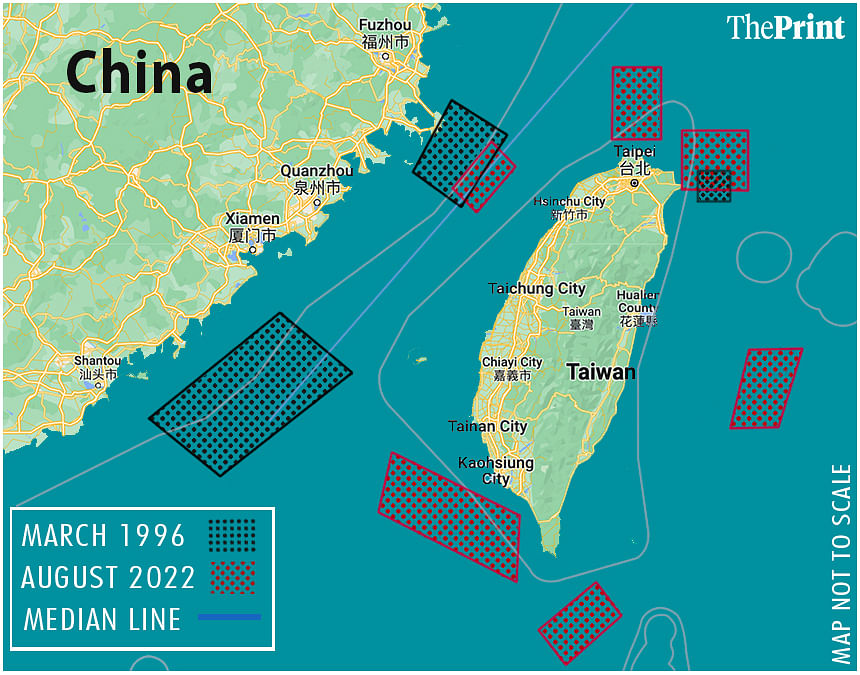New Delhi: The People’s Republic of China (PRC) has launched a swathe of military drills and exercises in retaliation for Nancy Pelosi’s visit to Taiwan.
Upon her arrival in Taipei Tuesday, Pelosi, Speaker of the US House of Representatives, had expressed solidarity with Taiwan, describing it as a “robust, vibrant democracy”.
Pelosi’s was the first high-profile visit by a top US official to Taiwan since the then House Speaker Newt Gingrich landed in Taipei in 1997. Pelosi’s 24-hour visit seems to have irked the PRC, which claims to be the “sole legal government” of China, of which Taiwan is an “inalienable part”.
The Chinese People’s Liberation Army (PLA) has begun a series of joint military operations in Taiwan’s territorial seas. According to Chinese state media, the PLA has launched a “joint blockade”, involving sea assault, and land and air combat training exercises around Taiwan. These include the use of J-20 stealth fighters and DF-17 hypersonic missiles.
The Taiwanese defence ministry has alleged that this fresh escalation by China is in violation of the island’s sovereignty — a deviation from past exercises. Taipei has also said that these drills may block sea lines of communication and shipping routes.
The PLA had upped the ante even before Pelosi’s arrival in Taipei by conducting military drills around Taiwan. Early Tuesday, multiple Chinese fighter jets flew near the median line that demarcates the Taiwan Strait.
China’s Southern Theatre Command, which oversees the PLA’s operations in the South China Sea and some Taiwan-related missions, was also put on high alert prior to Pelosi’s visit.
Also Read: How Xi juggled wolf-warrior diplomacy & nationalism to ‘send message’ on Pelosi’s Taiwan trip
Live-fire military drills
Soon after Pelosi’s arrival in Taipei Tuesday, the PLA declared that it would hold live-fire military drills — military exercises using live ammunition — from six zones around Taiwan.
Now underway, these drills will continue till 7 August and will involve a show of China’s military strength both on land and at sea.
Taylor Fravel, director of the security studies programme at the Massachusetts Institute of Technology (MIT), told Politico that the six zones where the PLA has planned its military drills “are so close to Taiwan”.
“There are so many closure areas so close to Taiwan. The scope of these areas literally attack Taiwan from four directions — east, south, west and north,” Fravel said.
In contrast to past exercises by the PLA, part of these live-fire drills will be held off the east coast of Taiwan. This is a region where the PLA’s Eastern Theatre Command has been very active over the past few years.
The drills, according to analysts, are much closer to Taiwan’s territorial waters than the drills conducted by the PLA in 1995-96 during the third Taiwan Strait Crisis — when Beijing fired missiles into Taiwan’s territorial seas in the run-up to the 1996 presidential election in Taipei.

With tensions running high, then US President Bill Clinton responded by ordering US aircraft carriers into the Taiwan Strait.
China’s arsenal
The PLA’s Eastern Theatre Command had already revealed that it would fire conventional missiles off the eastern coast of Taiwan as part of the drills, but there’s little clarity on the types that will be used.
Apart from the DF-17 ballistic missile that has already been launched as part of the ongoing live-fire drills, the PLA could could also deploy operational missiles in China’s arsenal.
According to the Center for Strategic and International Studies (CSIS), a Washington, DC-based think tank, these projectiles could include intercontinental ballistic missiles that are part of the Dongfeng (DF) ‘family’, Hong Niao cruise missiles, Julang (JL) submarine-launched ballistic missiles and Yingji (YJ) cruise missiles.
The Dongfeng missile family — featuring short-range, medium-range, intermediate-range, and intercontinental ballistic missiles — has been a staple for China since the 1960s after the transfer of arms systems technology between the erstwhile Soviet Union and China as part of the Sino-Soviet Treaty of Friendship, Alliance and Mutual Assistance.
As such, the DF-1, the first in the Dongfeng series, was a short-range ballistic missile (SRBM) and an officially licensed copy of the Soviet R-2.
The short-range DF-11 (also known as the M-11), the oldest Dongfeng missile still in operation, is believed to have paved the way for the development of Pakistan’s Ghaznavi SRBM. Beijing had sold 34 DF-11 missiles to Islamabad in 1992.
China also deployed the DF-15 — which has a maximum range of 600–900 km and can carry a payload of 500–750 kg — in military drills prior to the third Taiwan-Strait crisis.
“[The DF-15] is capable of striking Taiwan, the Korean Peninsula, and northern India from mainland China,” according to CSIS.
Islands under threat
Those closely watching tensions between China and Taiwan fear that Beijing could respond to Pelosi’s visit by capturing and annexing some of Taiwan’s outlying islands, which include Kinmen, Pratas, Mazu, and Dongding, among others.
China has attempted to capture or attack these in the past.
The PLA bombarded Taiwan’s Kinmen Island, located near China’s southeast coast, in September 1954. In 1958, the PLA bombarded Kinmen again, along with Mazu. This was followed by an attack on the Dongding island later that same year.
However, any attempts by China to capture these islands could test the US’s resolve, paving a path for further escalation.
(Edited by Amrtansh Arora)
Also Read: China expanding nuclear test facility, satellite images suggest construction in Xinjiang: report






